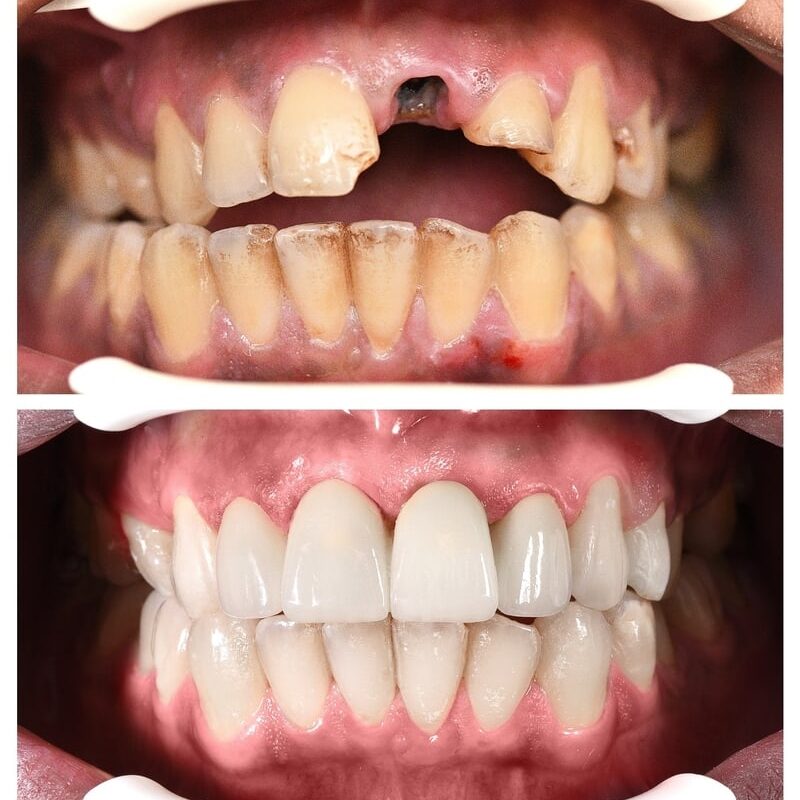A one-stage implant places a healing abutment into the bone at the time of a one-stage
surgery. The tissues around the abutment are given time to heal for up to six months before
the prosthesis is attached. One-stage implants may also be used in areas of the mouth where
cosmetic appearance is not a significant issue.
One Stage Implant Procedure
Treatment
About This Treatment
The Process
The one-stage implant procedure, also known as single-stage or
immediate-load dental implant procedure, is a methodology
where the dental implant and the abutment (the part that
protrudes above the gum line) are placed simultaneously,
eliminating the need for a second surgery to expose the implant.
Here’s a detailed overview:
Consultation and Assessment
- Dental Examination:
- Complete oral assessment, including health of gums and surrounding teeth.
- Imaging:
- Using X-rays or CT scans to evaluate bone quality, density, and to determine optimal implant placement sites.
- Treatment Planning:
- Discussing the procedure, recovery, costs, and potential alternative treatments.
One-Stage Implant Surgery
- Anesthesia:
- Administering local anesthesia (and possibly sedation, if required) to numb the area.
- Implant Placement:
- Drilling a hole into the jawbone where the implant will be situated.
- Inserting the dental implant into the predetermined position in the jawbone.
- Affixing the abutment onto the implant immediately.
Protection and Initial Recovery
- Temporary Restoration:
- In some cases, a temporary crown might be placed on the abutment, particularly if the implant is in a visible area of the mouth. This provides aesthetic value while the implant heals and integrates.
- Post-Operative Care:
- Providing guidelines on pain management, oral hygiene, diet, and potential signs of complications.
Osseointegration
- Healing Time:
- Even though this is a one-stage procedure, the implant still requires several weeks to months to fuse with the bone, a process known as osseointegration.
- It’s essential to be cautious during this period, avoiding hard or chewy foods that might displace the implant before it’s securely integrated.
Final Restoration
- Dental Impressions:
- Once osseointegration is confirmed, taking impressions or digital scans of the mouth to design the final crown.
- Crown Placement:
- Fixing the custom-designed crown onto the abutment, ensuring optimal fit, bite, and aesthetics.
Follow-Up and Maintenance
- Routine Check-ups:
- Periodic dental visits to ensure the health and stability of the implant and surrounding tissues.
- Oral Hygiene:
- Practicing regular oral hygiene, including brushing, flossing, and possibly using prescribed mouthwashes, to maintain implant and overall oral health.
Before and After
SEE OUR RESULTS
Patient Stories
The Dental Implant Institute has been an excellent dentist surgery that I have been attending as a patient for many years. When I was young I didn’t have a pleasant experience with my local dentist on more than one occasion. I found the dentist at The Dental Implant Institute very reassuring and comforting. The management…
A great surgery; Dr Javier in particular spent time with me to make sure my new night guards fitted well and were up to the job
I lost my two front teeth whilst at school and had complications for years. Unfortunately I ended up needing an implant – which I had been avoiding! I wish I had done it sooner. Dr Javier was fantastic and guided me through each stage. He was always contactable to answer any queries or concerns. Very…
FAQs
What is the difference between Stage 1 and Stage 2 implants?
Discomfort and pain after the second stage dental implant surgery are minimal compared to the first stage dental implant surgery where swelling and discomfort is present. So which procedure is best? The two stage dental implant surgery definitely has higher success rates but requires two surgeries.
How long does the first stage of an implant take?
The surgery is the real first step of the implant process. Your dentist will place the titanium implant in your jaw bone, right below the gums. This surgery usually takes about 1-2 hours for each implant being placed.
Will I be sedated before cosmetic teeth implants at your Chalfont St Peter practice?
Our dental implant procedures at The Dental Implant Institute are precisely planned. We usually place dental implants using local anaesthetic. Of course, if you’d prefer, we have a seditionist who can sedate you during the implant treatment to make it a relaxed experience.
What if I don’t have enough bone for dental implants?
The CBCT scan lets us know in advance of dental implant treatment if you don’t have the necessary height and width of bone. In this case, we can augment the bone using a bone graft, which can be done before or at the same time as your cosmetic teeth implant surgery.
Is the first stage of tooth implant painful?
A straightforward dental implant, for a patient with good bones and who does not need a lot of soft tissue surgery, has a pain level between two and three in the first 24 to 48 hours, which means over-the-counter medication like Tylenol or Advil will take care of any discomfort they are feeling.
What are the core advantages and potential limitations ingrained within the one-stage implant procedure?
One-stage implant procedures proffer a spectrum of advantages, notably minimizing surgical interventions by negating the need for a second-stage surgery to uncover the implant. It potentially accelerates the restorative timeline and might be particularly advantageous in aesthetically critical zones, ensuring gingival contours are sculpted and maintained from inception. However, limitations might encompass the potential for micro-movements due to the exposed nature of the implant during healing, which might impede optimal osseointegration. Additionally, meticulous care is requisite to avoid inadvertent loading during the healing phase, ensuring that osseointegration transpires unencumbered.
How does the healing and osseointegration phase in a one-stage implant procedure unfold, and what patient considerations are paramount during this period?
The healing and osseointegration phase within a one-stage implant procedure unfolds with the implant exposed through the gingival tissue, and it progresses similarly to traditional protocols in terms of bone integrating with the implant surface. During this period, patient considerations are pivotal, primarily focusing on avoiding any pressure or load on the protruding implant to safeguard against jeopardizing osseointegration. Meticulous oral hygiene, adherence to prescribed post-operative protocols, and avoidance of parafunctional habits also emerge as crucial to ensure that the healing phase transpires smoothly and effectively.
How does the one-stage implant procedure navigate through the aesthetic and functional dynamics in the anterior esthetic zone?
Navigating the aesthetic and functional dynamics in the anterior esthetic zone via a one-stage implant procedure necessitates a judicious blend of surgical acumen and prosthetic foresight. The exposed nature of the implant allows for immediate shaping of the peri-implant gingival contours, potentially utilizing provisional restorations to orchestrate aesthetic harmony from the onset. However, this demands meticulous planning to ensure that provisionalization does not impart undue forces on the implant during osseointegration, thereby curating an environment that fosters aesthetic optimization while stringently respecting biomechanical imperatives.
What protocols and technologies are integrated to enhance the predictability and success of one-stage implant procedures?
Integration of varied protocols and technologies is pivotal to enhance the predictability and success of one-stage implant procedures. Utilization of comprehensive diagnostic protocols, including 3D imaging via CBCT and meticulous treatment planning, forms the backbone of predictable outcomes. Additionally, adopting technologies such as digital impressions, virtual planning, and possibly guided surgery can further elevate precision and adherence to planned trajectories. Stringent post-operative and maintenance protocols further cascade into the procedural matrix, ensuring that each phase is meticulously navigated to culminate in successful integration and restoration of the implant.
Are there specific post-operative and maintenance protocols tailored for patients undergoing one-stage implant procedures?
Post-operative and maintenance protocols for one-stage implant procedures meld general post-implant care principles with specific considerations pertinent to the exposed nature of the implant during healing. Patients are educated and monitored to ensure that no forces, either through functional activity or inadvertent habits, are imparted on the healing implant. Emphasis on meticulous oral hygiene, utilizing appropriate tools and techniques, is underscored to mitigate the risk of peri-implant inflammation. Periodic evaluations and possibly interim prosthetic adjustments might be necessitated to ensure unimpeded healing, optimal osseointegration, and a harmonious transition into the restorative phase.
Book your consultation
Every journey begins with a detailed consultation. Our approach is always
bespoke, and your plan is individualised for you and your concerns.










